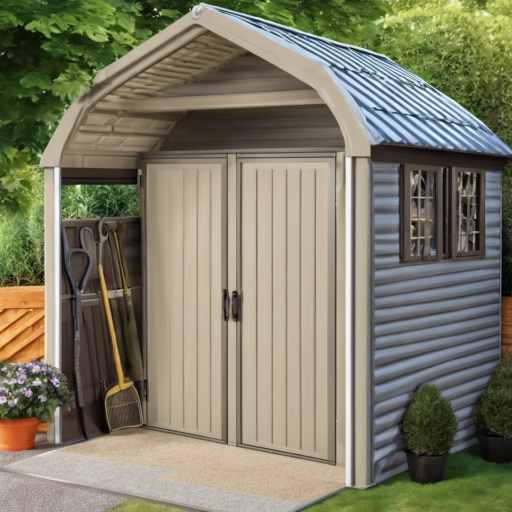What is the best foundation for a plastic shed?
What is the Best Foundation for a Plastic Shed?
When setting up a plastic shed in your backyard, choosing the right foundation is crucial. A solid and well-built foundation ensures the stability and durability of your shed, protecting it from potential damage and extending its lifespan. In this article, we will discuss the best foundations for plastic sheds and provide you with some practical tips to help you make an informed decision.
Why is a Foundation Important?
Before diving into the types of foundations, let's understand why a strong foundation is essential for your plastic shed. The foundation serves as the base on which your shed stands. It helps distribute the weight of the shed evenly, prevents shifting and settling, and keeps the shed above ground level, protecting it from moisture, insects, and potential flooding. Additionally, a well-built foundation allows for proper drainage and ventilation, preventing dampness and rot.
Types of Foundations for Plastic Sheds
Several foundation options are suitable for plastic sheds. Each option has its advantages and disadvantages, and the choice ultimately depends on factors such as the shed's size, location, local climate, and personal preference. Let's explore some common foundation types:
1. Concrete Slab Foundation
A concrete slab is a popular and sturdy foundation choice for plastic sheds. It provides a flat and level surface, ensuring stability and ease of installation. A well-built concrete slab can support heavy loads, making it suitable for larger sheds. Moreover, it offers excellent protection against moisture and pests, keeping your shed safe and dry. However, the installation of a concrete slab can be time-consuming and expensive, and it may require professional assistance.
2. Gravel Foundation
A gravel foundation is a cost-effective and relatively easy option for smaller plastic sheds. It involves preparing a level ground and filling it with compacted gravel. This type of foundation provides good drainage, preventing water accumulation around the shed. It also offers stability and flexibility, allowing slight adjustments if needed. However, gravel may shift over time, requiring occasional maintenance. To enhance stability, consider using a grid system or adding a border of treated wood or concrete blocks around the perimeter.
3. Wood Platform Foundation
Another popular foundation option is a wood platform. It involves building a framework with treated lumber and covering it with plywood. This foundation provides a level surface and is suitable for sheds of various sizes. It offers good ventilation, preventing moisture buildup. To enhance stability, consider adding concrete deck blocks beneath the support beams or anchoring the platform to the ground. However, a wood platform may require regular maintenance, such as painting or staining, to protect it from rot and decay.
4. Paver Foundation
Using concrete pavers as a foundation for your plastic shed offers several benefits. Pavers are durable, easy to install, and readily available. A paver foundation provides excellent drainage and stability while allowing airflow under the shed, preventing dampness. This option is especially useful if you plan to relocate or expand your shed in the future, as pavers can be easily rearranged or added to. Like other options, a paver foundation requires a level surface for proper installation.
5. Elevated Foundation
If you live in an area prone to flooding or heavy rainfall, an elevated foundation is a wise choice. This foundation involves constructing a raised platform using pressure-treated wood or concrete blocks. By keeping the shed above ground level, an elevated foundation protects it from water damage. Additionally, it allows for adequate airflow and easy access for maintenance. However, an elevated foundation may require stairs or a ramp for convenient entry into the shed.
Tips for Choosing the Right Foundation
Now that we've discussed the different foundation options, let's consider some important tips to help you choose the right foundation for your plastic shed:
-
Consider the Shed Size – Larger sheds typically require more substantial and stable foundations, such as concrete slabs or wood platforms.
-
Evaluate the Location – Assess the ground condition, slope, and drainage in your chosen location. Choose a foundation type that works best with the existing landscape.
-
Assess the Climate – Take into account the local climate and weather conditions. Ensure the foundation you choose can withstand heavy rain, snow, or extreme temperatures.
-
Budget – Determine your budget for the shed foundation. Concrete slabs may be more expensive, while gravel or wood platforms offer more affordable options.
-
Maintenance – Consider the level of maintenance required for each type of foundation. Some options, like concrete slabs, require minimal maintenance, while others may need regular upkeep.
-
Future Plans – If you plan on expanding or relocating your shed in the future, choose a foundation type that allows flexibility and easy modifications.
Conclusion
Choosing the best foundation for your plastic shed is crucial for its stability, durability, and longevity. Consider factors such as shed size, location, climate, and budget when making your decision. Whether you opt for a concrete slab, gravel foundation, wood platform, paver foundation, or elevated foundation, make sure to follow proper installation procedures to ensure a solid base for your shed. With the right foundation, you can enjoy your plastic shed for years to come.

